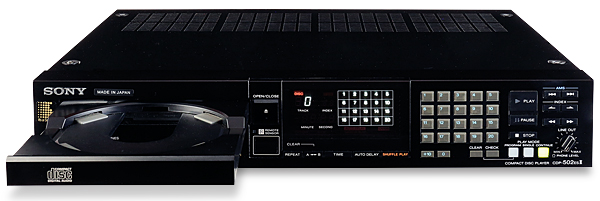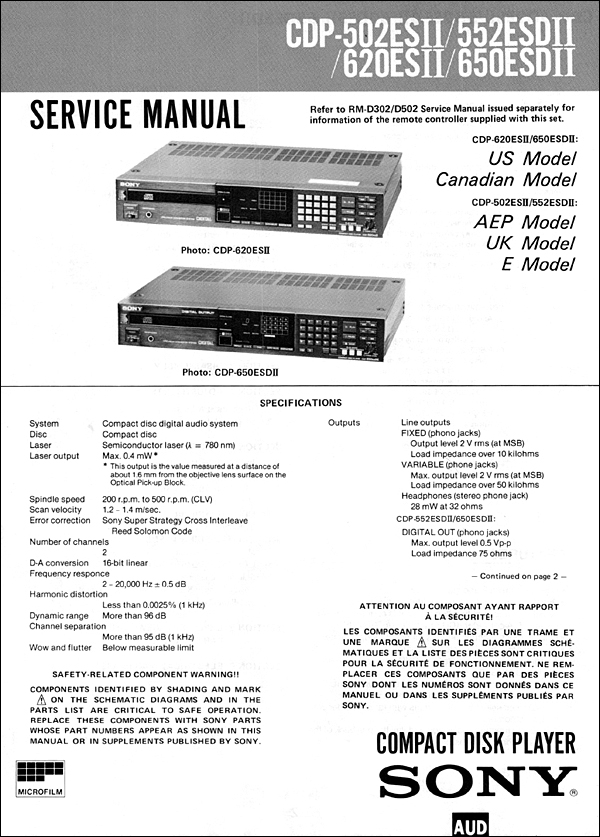Sony CDP-502ESII CD player

 This machine marked a step-change in Sony's assault on the early CD player market as the company ditched its own DAC in favour of a third-party solution. How will it sound?
This machine marked a step-change in Sony's assault on the early CD player market as the company ditched its own DAC in favour of a third-party solution. How will it sound?
The components in Sony's ES series represented what the company regarded as the most advanced designs available. They were top of the range, and aimed at those who were prepared to pay a little extra to obtain the best possible performance.
Launched in 1966 with the TA-1120 integrated amplifier and discontinued in the late 1990s, the ES series was always at the forefront of what Japan had to offer. It was inevitable, then, that Sony would introduce an ES CD player as soon as it was feasible. And when it came there were two models: the range-topping CDP-701ES and the slightly more affordable CDP-501ES.
Single Player
Both were based on the major parts of the company's – and world's – first ever CD player from 1982, the CDP-101 [HFN Jan '12]. Yet while impressive to look at, neither convincingly improved on the capabilities of the original machine.
Part of the problem with the CDP-501ES was its reliance on a single channel, time-shared DAC and the lack of a digital filter. Compared to the sophisticated dual DAC and digitally filtered units being made by Philips and Marantz, Sony was way off the pace, although clever marketing managed to disguise this from many buyers. Things improved in the autumn of 1985 when Sony revamped its top-end players, dropping the CDP-701ES in favour of a two-box pairing – the CDP-552ES (a complete CD player but used as a transport here) and DAS-702ES DAC. This two-box combo caused quite a stir, but at £2000 its appeal was limited. Meanwhile the CDP-501ES was joined by the CDP-502ES which looked essentially the same as the '552 (and '502ESII to come), but was a far more important product. At just under £700 it was still expensive but not excessively so, and as a result it became a strong seller to keen listeners.

Slim and beautifully finished in silky black anodised alloy, the CDP-502ES certainly looked the part. It was solid and heavy, weighing in at 8.5kg, its rigid steel chassis with plenty of copper plating contributing to this. Much work had been done to the functional parts of the player, with all traces of the CDP-101 design now gone. Intriguingly, a new type of laser pick-up was used, moved not by dawdling racks and gears but by a high-speed linear motor.
Do The Shuffle
This was a similar method to that used by Philips, but when deployed in a straight line (rather than an arc) and in conjunction with Sony's three-beam laser optics it resulted in a remarkably rapid access time to any point on the disc. Less than two seconds to play any track from any starting point was a typical figure. To complement this, the old tray mechanism with its noisy, grinding motors was supplanted by a new layout which was both fast and near silent. And these refinements made a new option possible: shuffle play, which enabled the machine to select tracks on a disc in random order. This feature would soon became universal, but was seldom as well executed as it was on the Sony CDP-502ES.
Other special facilities included a direct-entry numerical keypad for track selection and the option of a variable-level line output, controlled by a motorised potentiometer on the player's front panel. Both of these features were also to be found on the remote control handset – itself an unusual feature for a CD player at the time.

The CDP-502ES had at its heart a 2x oversampling digital filter. At a stroke this relieved a problem associated with early players like the CDP-101 that required a steep 'brick wall' analogue filter to deal with aliasing distortions. The 2x sample rate allowed a far more 'relaxed' filter to be employed.
Although well received, the CDP-502ES was not as sophisticated in every area as it first appeared. The DAC was still time-shared, meaning that an unavoidable phase error existed between the left and right channels. The digital filter effectively halved this effect, but at high frequencies it was still substantial.
Serious Upgrades
In the year that followed its launch, the CDP-502ES looked even less competitive. This was because Philips introduced the CD 650 and Marantz unveiled the CD-65, both of which employed dual 16-bit DACs and 4x oversampling.
Sony's response was the CDP-502ESII we have here. Outwardly almost identical, this machine addressed the shortcomings of the original version with some serious upgrades. Gone was the single Sony CX20152 DAC to be replaced by dual Burr-Brown PCM53s. This led to a redesign of all the supporting circuitry too, including the introduction of some novel techniques. One was the use of an internal optical link between the digital filter and DAC, allowing the use of split ground planes and power supplies to be optimised.

Despite this wholesale revision of the unit's DAC system the fascia legend 'Unilinear Converter System' remained. This moniker was used indiscriminatingly across the Sony range at the time and appears to have meant little. Once again the machine was highly acclaimed, both for its excellent ergonomics and fine audio performance.
To complete the system Sony offered its 444ES series of matching components. While all worthy products in their own right, none is as fondly remembered as the CD player, which found a home in mixed systems of all levels as well as Sony's own.
On The Buttons
Looking it it today, its hard not to love the CDP-502ESII. Sony knew better than anyone how to detail and finish its products to make them instantly desirable and this player looks the absolute business. The layout of the fascia is superbly executed too. Yes there are no fewer than 45 knobs, switches and buttons populating what is a fairly small area on the front, but this is still a simple machine to use.























































